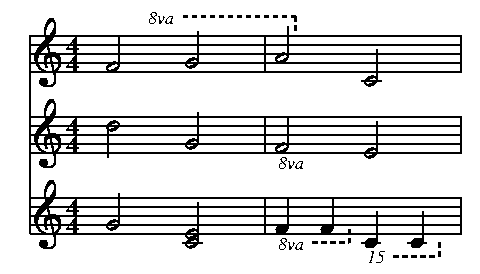<-- previous page Table of Contents Index next page -->
Octave statements are used to mark notes that are to be played one or more
octaves higher or lower than written. An "octave above" statement is
used to specify playing higher than written, or "octave below" for playing
lower than written. Each item must include a begintime
and a text string. The text string is most typically "8va" although Mup
will print whatever you say. For
MIDI
purposes, up to two digits at the beginning of the string are examined,
and a string starting with 8 will be treated as one octave,
15 or 16 will be treated as two octaves
(15 is really "correct," but a few publishers may use 16), 22 or 24 as three
octaves, etc. It will always default to be printed in 12-point
Times ital font, although you can override that using the usual \f
and \s conventions. If the octave
shifting applies to more than a single chord, there should also be a
duration specified, reaching to include the last affected note. In this
case, Mup will draw a dashed line to mark the span affected. Note that
specifying the exact beat of a chord indicates the horizontal center of the
chord, so if you want the dashed line to reach a bit past the note, it
will be necessary to specify a duration slightly beyond the point of
the last chord to be included. Examples:
1: 2f;g; 2: 2d+;g; 3: 2g;ce; octave above 1: 2 "8va" til 1m + 1.3; bar 1: 2a;c; 2: 2f;e; 3: 4f;;c;; octave below 2: 1 "8va"; octave below 3: 1 "8va" til 2.5; 3 "15" til 4.5; bar
